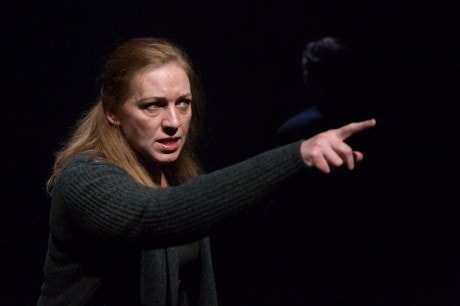Graphic language can slam us and disturb us in a way that is unique to live theater. Visceral and muscular diction in performance can burn images into our mind’s eye as no cinema can.The power of rhyme and explosive meter can so alter the synapses of conscious and subconscious cognition that the unimaginable claims our brain as its stage, and there we then witness acts and events that could not possibly be. Yet we see, we see clearly. And as we do so, what was only words becomes its own mental reality.

The language in Mark O’Rowe’s play Terminus cerebrally breaks through the fourth wall of stagecraft exactly like that. The Irish playwright O’Rowe has forged a formidable verbal score. Three virtuoso actors voice it, delivering three interlocking and intersecting monologues in Dublinesque inflection. And in the timespace of an hour and 45 minutes their three characters’ riveting fiction summons from us a kind of attention that makes us more than spectators or mere hearers. The linguistic intensity makes us complicit in completion of what began in the writer’s perfervid and fevered mind.
The three actors are identified in the program as A, B, and C. The character A is a woman who works at a suicide hotline where she gets a call from a young woman who intends to terminate a near-term pregnancy, and who turns out to be the woman’s estranged daughter. Nanna Ingvarsson makes this mother’s anguish achingly vivid, and then horrifying as the character’s vengeful violence emerges. The character B is the young woman, and on a late-night sexcapade that goes horribly wrong, she plummets from a precipitous height but is saved from certain death by a flying demon made of worms. That moment of magical rescue about 15 minutes into the play marks its shift from the recognizable into the horror-show surreal, and Katie Ryan’s breathtaking performance impels a momentum that sweeps us beyond incredulity into awe. The character C is a horny and lonely guy with a scary streak; he’s terrified of women and becomes an unhinged serial killer. Dylan Meyers’s performance, an admixture of charm and alarming guile, is transfixing.
In the various monologues, the character arcs connect, but we know that by inference, based on bits and pieces in the tales they tell; the actors themselves do not interact; they speak their raw arias individually and separately. I was struck by how distinctly Ingvarsson, Ryan, and Meyers each bring O’Rowe’s rich text to life with character-defining specificity. So compelling is the narrative world that each actor creates, in fact, that I found the transitions between monologues abrupt, as if each long speech was over too soon.
Throughout O’Rowe has given the actors language with some intriguing poetic techniques. Its tight metric construction makes it unforgiving of any inadvertent syllable out of place. And its reiterative internal rhyme especially is gloriously trippy. Here, for instance, is character A, in her first monologue, on a mission to prevent the young woman from having an abortion (the internal rhymes are kind of hidden unless you read it aloud):
…I can’t relent. Hell bent as I am on being her salvation, I station myself at the [curb] and nab a cab, the driver a blabbermouth. I tune him out and drift and, miffed at my lack of response to his shit, he quits his attempts to engage and sits in a childish rage til we’re there and, having paid my fare and got out, I hear, as he pulls away, him say, or rather grunt, “You cunt!” and, unfazed by his curse – I’ve been called worse – I go to her gate and enter, knock and wait on tenterhooks til she answers the door.

Director Tom Story has masterminded this verbal venture into the mindscape with extraordinary precision and passion. There’s minimal blocking, there’s really just talking. And Story has paced and shaped each actor’s soliloquy with singular grace. Set Designer Deborah Thomas has provided a city-street platform featuring a grating beneath which, thanks to Lighting and Sound Designer Adrian Rodney, an underground train rumbles and blows up debris as it goes by.
Terminus is not a play you can urge someone to go see, because its story takes place in one’s imagination more than in conventional stage action. And some aspects of that story are coarse and grisly. I myself involuntarily jumped in my seat at one point, upon hearing Ingvarsson utter a single word, “pop,” when her character gouged out someone’s eyeballs. And when some errant worms come loose from the Good Samaritan demon such that character B must replace them, you might be amused (as I and many in the audience were) or grossed out. So be advised.
But these performers are top-notch. They create through O’Rowe’s words a triptych of unforgettable portrayals that is not to be missed. And for lovers of deliciously well-wrought language, Terminus is like a trip to the ear candy shop.
Running Time: one hour and 50 minutes, without an intermission.
Terminus plays through January 4, 2015 at The Studio Theatre’s 2ndStage – 1501 14th Street NW, in Washington, DC. For tickets, call the box office at (202) 332-3300, or purchase them online.
LINK
Robert Michael Oliver’s review of Terminus on DCMetroTheaterArts.





